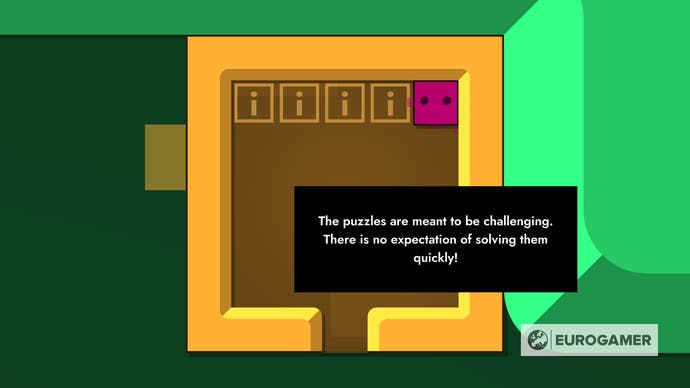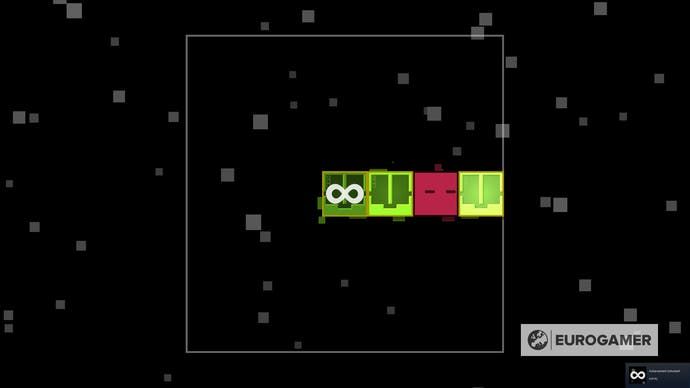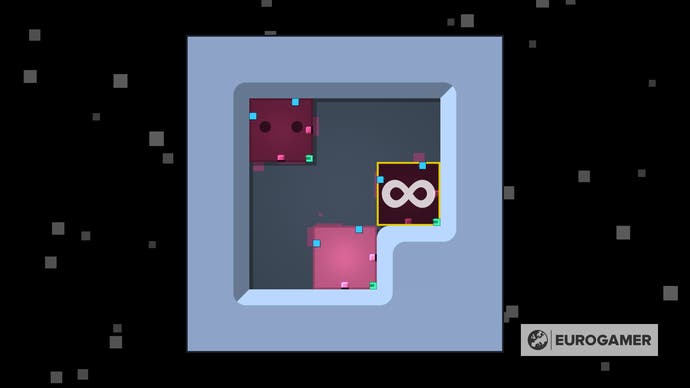Patrick's Parabox review - a minimalist puzzler of beautiful recursive depth
Infinite nest.
According to one famous linguist, what makes humans special is our ability to deal in recursion. To take different clauses or concepts and nest them within each other like Russian dolls. And from these beautiful, simple, recursive mergings spring near-infinite forms of expression. Anyway, whether or not recursion is the essence of the human mind, it is fun to mess about with.
If you haven't, you should try. Take a photo of yourself holding a photo of yourself holding a photo of yourself. Or turn your webcam towards the screen and watch the picture loop in on itself in a never-ending spiral. Or, if you're feeling especially bold in a zoom meeting, unmute yourself, feed the speaker output back into the microphone, and surprise your valued colleagues with the unfiltered scream of infinity. There's something hopelessly arresting about recursion and, although a few different games have played with it, it's underexplored design space. Enter Patrick's Parabox, 'a mind-bending recursive puzzle game about boxes within boxes within boxes within boxes'.
It's a winning description but, and let's get this out of the way, when I booted the game it wasn't love at first sight. The presentation is cute but basic and, dare I say it, sometimes unpolished. The UI isn't mousable and the menus are busy. The background music has good vibes, but loops too soon and chafes in long play sessions. Also, the game is named after its creator. 'Patrick's Parabox. Developer: Patrick Traynor. Publisher: Patrick Traynor.' That's impressive, certainly, and fittingly recursive, but a touch egoistic for my taste. I'm here for the puzzles, not the person. Anyhow, you play as this little square lad with cute little eyes, and I decided that he was called Patrick, and the game was named after him, and that made things more palatable.
So, you guide little Patrick around a box. And the goal is simple. You have to push boxes into marked-out spaces. Then you have to put Patrick himself into his own marked-out space. Then the level is done. That's it.
If boxes are the first puzzle ingredient, walls are the second. When you push a box against a wall, it stops. You can use the resistance of a wall to wedge one box inside another. Or sometimes inside itself - we'll get to that. Walls are essential tools, but they're also hazards. Push a box against a flat wall and it's stuck on one axis. Push one into a corner and it's stuck completely. Luckily, if you slip up or push the wrong box against the wrong wall, you can rewind any mistakes. And if you make a complete mess, one button will reset everything in an instant.


So far, so simple. But here's where it gets trippy. Sometimes these boxes are nested within themselves recursively. So as Patrick moves around, you can see an even smaller Patrick scuttling about in an identical box within your box, and a giant Patrick stomping around outside. You can dive infinite-floors-deep into these boxes. Boxception. It's only slightly less mind-bending than it sounds. And with just a few more simple mechanics, things get very weird indeed.
The game is split into twenty-ish worlds, each of them, fittingly, a box within a box. Each introduces its own little twist or complication, with twenty-ish levels that riff on this concept. One world has a mirroring mechanic, where the box-within-a-box is flipped. Another has you pushing long lines of boxes into themselves in an infinite recursive parade. One particularly disconcerting set of levels fills Patrick full of little crevices that you can fit boxes into, inducing mild trypophobia.


With a concept as mind-twisting as recursion, a game risks being scuppered by its own creativity. Too much complexity, too much stuff to remember or too much brute force trial and error. But Patrick's Parabox is a masterclass in simplicity, tempo and guided learning. Except for one room with some useful tooltips, there's no tutorial. Instead, concepts are introduced one by one, slowly building up intuition, giving you the tools you need to go further, the guiding hand invisible and unnoticed. Sometimes it's too minimalist. It took me longer than I should admit to find the level select screen. But mostly it's spot on.
The balance is also faultless. Difficulty can be a source of friction in puzzle games, but, here, progression only requires you to complete a set number of basic stages. And these basic levels are all perfectly pitched and paced. A minute of head scratching, some brow furrowing, and then everything clicks and the seemingly impossible resolves into a genius eureka moment. And these levels unfailingly hit the cadence goldilocks zone: long enough to be toothsome, short enough to not try your patience, and each introducing a delightful new idea. Even for someone with a wandering attention span, they're morish, and captivating and never monotonous.
By the last few stages I was nodding along, muttering 'Brilliant!' and 'Genius!'
The harder levels, demarcated with thick red borders, are optional. They take ideas from the basic levels and get twisted with them. Some are proper tough. That can be a good thing. With trial and error and a bit of lateral thinking, the solution arrives and you feel like Einstein. Other times it's maddening. You can half see the solution, but your mind won't knot itself into the necessary number of recursive folds and you're left stupid, clueless, staring into little Patrick's hateful, beady little eyes, cursing the Patrick who made him and all other Patricks that ever were and ever shall be. But! If stuck, it's easy to move on, and the game never belittles you for failure. These levels do have ominous red borders after all, and a friendly tooltip tells you to take heart because 'the puzzles are made to be challenging'. Coming from the untempered sadism of Elden Ring, it's a welcome breather.


My experience with Patrick's Parabox, then, was itself nested like a Russian doll. Looking at the outer layer, I wasn't sold. Yet another nondescript puzzler in a sea of hundreds, with some style but a few rough edges. One layer deeper it started to click. Okay, this is fun. I don't know how it won all these indie design awards but by jove I'll solve this puzzle. By the last few stages, though, I was nodding along, muttering 'Brilliant!' and 'Genius!'
The game is generous with optional content. Three-hundred plus levels and tools for the community to develop more. I've a few harder levels left to chew on, and the more fiendish puzzles in the endgame challenge room will occupy me for weeks. But, without going yet deeper into the Patrick fractal, this much is certain: if you're in the mood for an imaginative little puzzler, this is the one. It's the best I've played in ages. It has all the inventive spark I'd expect of Nintendo EAD. Tripley impressive from a young, independent, two-person development collaboration. Stick to the main path and it's a playful, accessible palette-cleanser; a toybox of delightful ideas that never outstay their welcome. Head off the beaten track, though, and it has boxes within boxes within boxes and depths within depths within depths.


